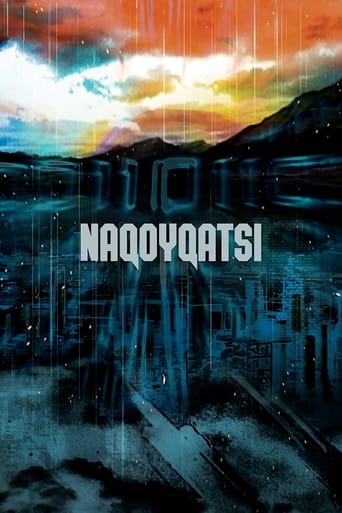

Welcome to the digital age, a world of speed, cultural hybridity, multi media, and perceptual overload, all of which are expressed beautifully in Godfrey Reggio's third entry Naqoyquatsi. This one is vastly different from the previous two. Wheras Koyaanisqatsi and Powaquatsi were done in the real world, much of Naqoyqatsi is done on the computer. Using just about every computer graphic available at the time, Naqoyqatsi feels more like a piece of art than the other two. After deciding that Powaqatsi was a dud, I was pleased to see that Godfrey Reggio made a recovery. Naqoyqatsi is almost on par with it's fore father Koyanisquatsi, although depending on which on you see first, you may prefer this one. This one strikes me as less epic than Koyanis, in part because it's faster editing allows for much more advanced montages which are so overwhelming at times that they occasionally provoke headache.The message behind this film is the way humanity is a competitive species. I think Alfred Adler would adore this movie. One of Freud's students, he believed that the human condition is based on seeking superiority. Naqoyqatsi shows us two forms of competition. One is sporting events, and the other is physical war and fighting.Phillip Glass once again, works his musical magic, although it seems like some of the score was borrowed from Koyaanisqatsi. Together, Reggio and Glass have provided a trilogy of sights and sounds that defy all the conventions of cinema, to favour aesthetics.
... View MoreKoyaanisqatsi and Powaqqatsi are both Beautiful films, but this final installment of the trilogy is a major let down. They got too carried away with stock footage and photography, so little content. The executive producer puts his own image in the film... Its just pretentious. Maybe if they had more than $3 million to spend maybe it would have been something. I actually thought Steven Soderbergh directed it because it was so bad, but Godfrey Reggio the director of Koyaanisqatsi and Powaqqatsi directed this. I'll have to assume that they just didn't have the budget to make a decent film. You would think that Francis Ford Coppola would have wanted to be a part of this film and help get more money together.
... View MoreAfter watching Koyaanisqatsi, I found another movie which related to it. It was called "Naqoyqatsi" which meant "Life At War".This movie/documentary, shows 89 minutes of how we pick up violence , self-destruction, clonage and how modern technology has changed us , as humans over the years of the 20th century. Each and every pro and con is displayed! this movie will show you spectacular cinematography, magnificent sound effects and a brilliant theme for the movie which bell-like voices singing Naqoyqatsi.Once you have watched Koyaanisqatsi, get out the NAQOYQATSI!! It's as brilliant as the first!!
... View MoreHaving enjoyed Koyaanisqatsi and Powaqatsi I was looking forward to this third part of the Qatsi trilogy and seeing what direction it had taken. Rarely has a film so spectacularly failed to live up to its predecessors and lost its way. Although it tries to represent "civilised warfare" in the form of sport, science, trade and other forms of competition, it lacks the global scope and even the coherently developed themes of its predecessors. War is chaos, but even wars have an aim in mind and this film had little structure and unclear goals.Naqoyqatsi is flawed by being a chaotic melange of images that does little to develop its theme. On the plus side, it wisely avoided using some of the iconic images of last century's wars.Naqoyqatsi is also so insular that several times I had to remind myself that I was not watching an advertisement promoting the American way of life. Perhaps this insularity reflects the ongoing "War on Terror". When representing "sport as war" the prominent team logos ensured that the USA was depicted as the winner. Hence it missed the opportunity to depict some of the many sports around the world and showing that humanity is united in its use of sport as a form of civilised warfare.Apart from newsreel, the footage seemed to have been shot on a budget in the confines of New York and there was little recognition of "life as war" in the rest of the world. The gallery of faces (waxworks) gave only a nod to the existence of important personages outside of the USA. The makers missed the point that globalisation does not mean Americanisation.The Philip Glass soundtrack sounded much like every other Philip Glass score I've heard (with the possible exception of Koyaanisqatsi) and at best can be described as "inoffensive" neither adding to, nor detracting from, the chaotic imagery.
... View More